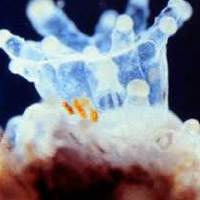 |
 |
 |
 |
 |
การแยกและเลี้ยง zooxanthellae สายพันธุ์ทนร้อนจากปะการังและสองฝา (Isolation and culture of thermal tolerance stain of zooxanthellae from corals and marine bivalve) รศ. ดร. ไทยถาวร เลิศวิทยาประสิทธิ |
บทคัดย่อ
ปรากฏการณ์ปะการังฟอกขาวเกิดขึ้นเมื่อมีการลดต่ำลงของความหนาแน่นเซลล์และ/หรือปริมาณของรงควัตถุที่ใช้ในการสังเคราะห์แสงของซูแซนแทลลี ซึ่งเป็นผู้อาศัยแบบพึ่งพาในเนื้อเยื่อของปะการัง โดยมีสาเหตุจากสภาวะแวดล้อมเปลี่ยนแปลงไปจากเดิม เช่น เมื่ออุณหภูมิเพิ่มสูงขึ้นและความเค็มลดต่ำลง เพื่อให้ทราบบทบาทความสำคัญของปัจจัยดังกล่าวจึงได้ทำการศึกษาความทนทานต่ออุณหภูมิและความความเค็มในซูแซนแทลลี ที่แยกจากปะการังดอกกะหล่ำ Pocillopora damicornis โดยทำการแยกเลี้ยงเซลล์ซูแซนแทลลีแบบปลอดเชื้อ ที่ 3 ระดับอุณหภูมิ ได้แก่ 25 (ควบคุม), 27 และ 33 องศาเซลเซียส โดยในแต่ละระดับอุณหภูมิประกอบด้วยชุดการทดลอง 5 ระดับความเค็ม ได้แก่ 10, 15, 25, 28 (ควบคุม) และ 33 พีเอสยู ทำการสุ่มนับเซลล์ทุก 2 วัน เป็นเวลา 14 วัน และคำนวณอัตราการเติบโตจำเพาะ พบว่าอัตราการเติบโตจำเพาะของซูแซนแทลลีมีค่าลดลงที่อุณหภูมิสูงและความเค็มต่ำ โดยที่อุณหภูมิ 33 องศาเซลเซียส อัตราการเติบโตของซูแซนแทลลีลดลงในทุกระดับความเค็ม ในขณะที่อุณหภูมิ 25 และ 27 องศาเซลเซียส ซูแซนแทลลีจะมีอัตราการเติบโตลดลงที่ความเค็มต่ำที่ 10 และ 15 พีเอสยู เท่านั้น จากผลการทดลองชี้ให้เห็นว่า อุณหภูมิสูงและความเค็มต่ำส่งผลต่อการเติบโตของซูแซนแทลลี ซึ่งอาจจะเกิดจากปัจจัยใดปัจจัยหนึ่ง หรือทั้งสองปัจจัยร่วมกัน
คําสําคัญ: อุณหภูมิ, ความเค็ม, ซูแซนเทลลี, Pocillopora damicornis
Abstract
Coral bleaching occurs when cell density and/or the concentration of
photosynthetic pigments of the endosymbionts; zooxanthellae are decreased. It has been proposed that the cause of this may be due to environmental stresses such as elevated temperature and decreased in water salinity. This study analysed characteristics of the endosymbiont; Pocillopora damicornis to clarify the potential importance of temperature and salinity on zooxanthellae. The growth responses of axenic culture were observed at 3 levels of temperatures; 25 (control), 27 and 33 oC. At each temperature level, 5 levels of salinities; 10, 15, 25, 28 (control) and 33 psu were assigned. Sampling cells were enumerated every 2 days for 14 days from which the specific growth rates were determined. The decreasing specific growth rates of zooxanthellae were observed at high temperatures and low salinity levels. At the highest temperature, 33 oC, at all levels of salinity, a decrease in growth rate of zooxanthellae was found. While at 25 and 27 oC, a decrease in growth of zooxanthellae was observed only at the lowest salinities; 10 and 15 psu. These results suggest that both temperature and salinity may have a singular and combined affect on the growth rate of zooxanthallae.
Key words: temperature, salinity, zooxanthellae, Pocillopora damicornis
งานวิจัยทั้งหมดมีลิขสิทธิ์
ผู้ละเมิดจะได้รับโทษสูงสุดตามที่กฎหมายกำหนด
สนใจข้อมูลเพิ่มเติม หรือมีข้อสงสัย
โปรดติดต่อโครงการฯ เพื่อการอ้างอิงหรือเผยแพร่ก่อนทุกครั้ง